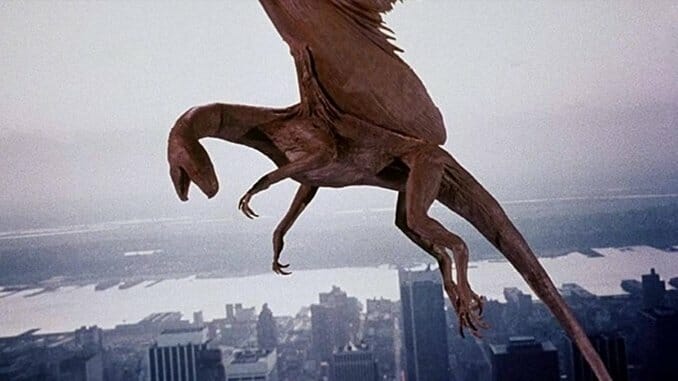
Paste’s ABCs of Horror is a 26-day project that highlights some of our favorite horror films from each letter of the alphabet. The only criteria: The films chosen can’t have been used in last year’s Century of Terror, a 100-day project to choose the best horror film of every year from 1920-2019. With some heavy hitters out of the way, which movies will we choose?
Let’s face it: “Q” is not the easiest or most fertile letter of this particular, ABC-driven endeavor. Whereas many letters of the alphabet offer no shortage of choices for our perusal, “Q” is mostly populated by dregs—that, and the memorably grimy weirdness of the conveniently titled Q: The Winged Serpent. Larry Cohen’s 1982 monster movie is a study in bizarre contrasts, and stands out as perhaps one of the strangest genre efforts of its era on multiple levels.
There’s no beating around the bush here, as a window-washer’s bloody decapitation within the first minute of the film nicely sets the tone and illustrates that there’s not going to be any mystery to what is happening here—a giant flying reptile is on the loose, and it has a taste for human skulls, chomping them with an absurd sound effect that sounds very much like a foley guy biting into a particularly crunchy apple. A pair of police detectives played by David Carradine and Richard Roundtree (Shaft himself!) are on the case, cataloging giant monster sightings and connecting the deaths with a spate of ritualistic serial killings that seem to suggest the presence of an Aztec death cult in 1980s New York. Could the two be connected??? The city government seems oddly unfazed at the prospect of a giant flying monster running amok, or perhaps Cohen—the director of classic shlock like mutant killer baby movie It’s Alive—just didn’t think to work in the histrionic aide from the mayor’s office you’d expect to see. In fact, Cohen hardly seems concerned with the monster himself at times, and that’s because he found quite the oddball muse to focus on instead, in the form of actor Michael Moriarty.
Moriarty is our actual protagonist here, rather than the aforementioned police detectives—instead, we’re following Moriarty’s “Jimmy Quinn,” a neurotic small-time crook in bed with the mob, who bungles a diamond heist and then flees, for reasons that don’t make any particular sense, to hide in the art deco spire of the Chrysler Building. There he discovers the lair of the titular flying serpent, along with a pile of bones and a giant egg, subsequently hatching a plan: He’ll extort the city with his knowledge of the creature’s location, making them pay a king’s ransom if they want to stop its reign of terror.
Suffice to say, Jimmy Quinn is a uniquely oily, despicable and weirdly sympathetic character, and the antithesis to your standard creature feature hero. He’s a crook who dreams of becoming a successful jazz pianist of all things, living with a harried girlfriend in a tiny shithole of an apartment plastered with Hammer Dracula movie posters. The man is a down-on-his-luck huckster, always destined to be taken advantage of by the world, coming off like a cross between the pitiable Jack Lemon of Glengarry Glen Ross and the deluded Rupert Pupkin of Scoresese’s King of Comedy, which captures a very similarly grimy New York City. He speaks in rambling, desperate run-on sentences that feel half improvised, claiming at one point that he served time after being framed on phony drug charges trumped up by the police and the city. We have no idea whether to believe him, but somehow we’re rooting for the guy, recognizing that he’s just one helpless rat in a nest of even bigger and meaner rats.
If there’s one thing that’s not going to help Quinn’s lot in life, though, it’s the inflation of his ego that comes immediately with the arrival of a little bit of power. Beguiled by the attention and notoriety of finally having a captive audience that is forced to admit it needs something he has, he lords his knowledge of the “winged serpent” over the police department, savoring the experience as they squirm, even as he seems to know instinctively that his moment in the sun will be short indeed. If this sounds like material that would normally be relegated to the background of a “monster movie,” then you’re correct—Q: The Winged Serpent takes a character who would normally be ancillary in anyone else’s movie and somehow places him front and center.
The monster does appear, of course, although the lack of a budget often means the broad daylight attacks occur in very brief flashes that suggest more than they actually show. Despite that, and the silly nature of the conceit, the violence is often surprisingly gruesome, whether it’s the monster casually chomping heads or the crazed Aztec priest flaying a man alive. In fact, for brief moments the sequences of mutilation call to mind the splatter films of Herschel Gordon Lewis, so cavalier are they with the gore. It all builds to the true FX payoff in the film’s final sequences, when we can finally witness The Winged Serpent in all its groovy stop-motion glory, engaging in a gun battle with squadrons of police against rear-projected backgrounds that are charmingly terrible.
Q: The Winged Serpent is not the first film someone is likely to mention in a Larry Cohen retrospective—that would probably be 1985’s The Stuff—but it’s an excellent illustration of the director’s fiercely independent streak and his interest in telling the stories of aberrant individuals within the framework of conventional genre movies. Like the city itself, caked in a permanent layer of grime and misery, Cohen’s ethos finds a way to assert itself, even in a movie about large, flying reptiles.
Jim Vorel is a Paste staff writer and resident horror guru. You can follow him on Twitter for more film and TV writing.